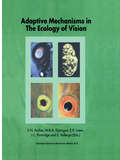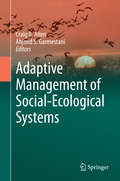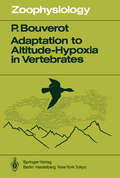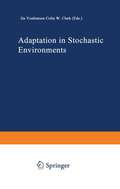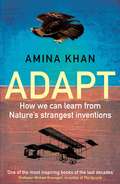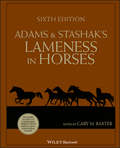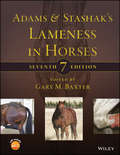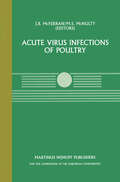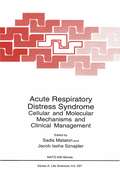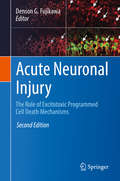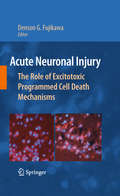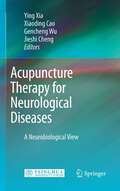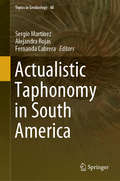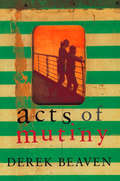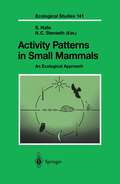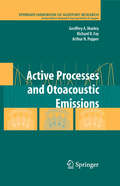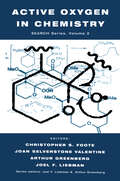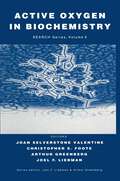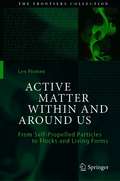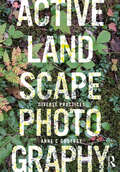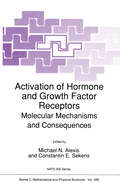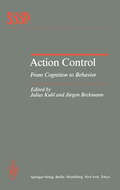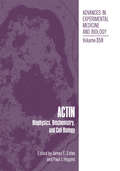- Table View
- List View
Adaptive Mechanisms in the Ecology of Vision
by S. Archer M. B. Djamgoz E. Loew J. C. Partridge S. VallergaJohn Lythgoe was one of the pioneers of the 'Ecology of Vision', a subject that he ably delineated in his classic and inspirational book published some 20 years ago [1]. At heart, the original book aimed generally to identify inter-relationships between vision, animal behaviour and the environment. John Lythgoe excelled at identifying the interesting 'questions' in the ecology of an animal that fitted the 'answers' presented by an analysis of the visual system. Over the last twenty years, however, since Lythgoe's landmark publication, much progress has been made and the field has broadened considerably. In particular, our understanding of the 'adaptive mechanisms' underlying the ecology of vision has reached considerable depths, extending to the molecular dimension, partly as a result of development and application of new techniques. This complements the advances made in parallel in clinically oriented vision research [2]. The current book endeavours to review the progress made in the ecology of vision field by bringing together many of the major researchers presently active in the expanded subject area. The contents deal with theoretical and physical considerations of light and photoreception, present examples of visual system structure and function, and delve into aspects of visual behaviour and communi cation. Throughout the book, we have tried to emphasise one of the major themes to emerge within the ecology of vision: the high degree of adaptability that visual mechanisms are capable of undergoing in response to diverse, and dynamic, environments and behaviours.
Adaptive Management of Social-Ecological Systems
by Craig R. Allen Ahjond S. GarmestaniAdaptive management is an approach to managing social-ecological systems that fosters learning about the systems being managed and remains at the forefront of environmental management nearly 40 years after its original conception. Adaptive management persists because it allows action despite uncertainty, and uncertainty is reduced when learning occurs during the management process. Often termed “learning by doing”, the allure of this management approach has entrenched the concept widely in agency direction and statutory mandates across the globe. This exceptional volume is a collection of essays on the past, present and future of adaptive management written by prominent authors with long experience in developing, implementing, and assessing adaptive management. Moving forward, the book provides policymakers, managers and scientists a powerful tool for managing for resilience in the face of uncertainty.
Adaptation to Altitude-Hypoxia in Vertebrates (Zoophysiology #16)
by P. BouverotAdaptation to altitude hypoxia is characterized by a variety offunctional changes which collectively facilitate oxygen trans port from the ambient medium to the cells of the body. All of these changes can be seen at one time or another in the course of hypoxic exposure. Yet, as already stressed (Hannon and Vogel, 1977), an examination of the literature gives only a sketchy and often conflicting picture of the exact nature of these changes and how they interact as a function of exposure duration. This is partly because of the limited number of variables explored in a given study, but it is also attributable to differences in experimental design, differences among species in susceptibility to hypoxia, nonstandardized experimental conditions, lack of proper control of physical (e. g. , temperature) and physiological variables (e. g. , body mass), failure to take measurements at key periods of exposure, and gaps in knowledge about some fundamental mechanisms. Furthermore the available data on animals native to high altitude are meager and/or inconclusive. Extensive further work under well-controlled experimental conditions is required before a detailed picture can be made. Nevertheless, it has been a guiding principle in the prepara tion of this monograph rather to summarize the vastly dis persed material that constitutes the comparative physiology of adaptation to high altitude into a coherent picture, than to provide a comprehensive survey of the field.
Adaptation in Stochastic Environments (Lecture Notes in Biomathematics #98)
by Jin Yoshimura Colin W. ClarkThe classical theory of natural selection, as developed by Fisher, Haldane, and 'Wright, and their followers, is in a sense a statistical theory. By and large the classical theory assumes that the underlying environment in which evolution transpires is both constant and stable - the theory is in this sense deterministic. In reality, on the other hand, nature is almost always changing and unstable. We do not yet possess a complete theory of natural selection in stochastic environ ments. Perhaps it has been thought that such a theory is unimportant, or that it would be too difficult. Our own view is that the time is now ripe for the development of a probabilistic theory of natural selection. The present volume is an attempt to provide an elementary introduction to this probabilistic theory. Each author was asked to con tribute a simple, basic introduction to his or her specialty, including lively discussions and speculation. We hope that the book contributes further to the understanding of the roles of "Chance and Necessity" (Monod 1971) as integrated components of adaptation in nature.
Adapt: How We Can Learn from Nature's Strangest Inventions
by Amina KhanNature's creations are more sophisticated and elegant than anything humans have created. Geckos can run upside down along ceilings. Termite mounds can stay cool in the desert without air conditioning. Adapt explores how we can harness such ideas through the ground-breaking new science of biomimicry - which looks to nature to solve pressing problems in engineering and science. From the depths of the oceans to the ice sheets of the Arctic, Amina Khan talks to the researchers at the forefront of this exciting new science, who are designing everything from wind turbines to military camouflage. An entertaining eulogy to the power of evolution, this captivating book is a must read for anyone with an interest in design, nature and technology.Khan leaves no stone unturned... Readers will leave this book with a buzzing excitement. - BBC Wildlife
Adams and Stashak's Lameness in Horses
by Gary M. BaxterThe Sixth Edition of Adams and Stashak’s Lameness in Horses builds on the book’s reputation as the classic gold-standard reference on equine lameness. Now in full color, the text has been fully revised and streamlined to improve user-friendliness, with a new, simplified format and a stronger emphasis on the diagnosis and management of lameness. A valuable supplementary DVD provides a complete guide to diagnosing lameness, offering additional anatomical images; video clips demonstrating key procedures such as physical examination, flexion tests, perineural and intrasynovial anesthesia; and examples of lameness conditions in motion. The Sixth Edition presents new or significantly rewritten chapters on the axial skeleton, principles of musculoskeletal disease, principles of therapy for lameness, occupation-related lameness conditions, and lameness in the young horse. The diagnostic procedures chapter has also been significantly expanded to reflect advances in this important area. Adams and Stashak’s Lameness in Horses, Sixth Edition is an essential addition to any equine practitioner’s bookshelf.
Adams and Stashak's Lameness in Horses
by Gary M. BaxterProvides a fully updated Seventh Edition of the classic gold-standard reference on equine lameness This new edition of the go-to resource for equine lameness features updates throughout and more in-depth information on objective lameness assessment, sports medicine, rehabilitation, treatment options, and advanced imaging. With contributions from the world’s leading authorities on the subject, the book covers functional anatomy, examination, imaging, lameness of the distal limb, proximal limb, and axial skeleton, principles of musculoskeletal disease, therapies, occupation-related conditions, lameness in young horses, and farriery. More than 1,700 images support the text, making it an exhaustive reference for all aspects of lameness in horses. Now in its seventh edition, Adams and Stashak’s Lameness in Horses continues to be the definitive resource on equine lameness for veterinary specialists, practitioners, interns, residents, and students alike. The book is supplemented with a companion website offering a plethora of “how-to” videos demonstrating lameness examination and select perineural and intrasynovial anesthesia techniques. Offers a fully revised new edition of the classic text on equine lameness Includes more extensive information on objective lameness assessment, sports medicine, rehabilitation, treatment options and advanced imaging Features over 1,700 images to illustrate the concepts described Written by internationally renowned experts in the field Includes access to a companion website with "how-to" videos Adams and Stashak’s Lameness in Horses is a must-have reference for any practicing large animal and equine veterinarian, equine veterinary specialist, or veterinary student dealing with lameness in the horse.
Adams and Stashak's Lameness in Horses
by Gary M. BaxterProvides a fully updated Seventh Edition of the classic gold-standard reference on equine lameness This new edition of the go-to resource for equine lameness features updates throughout and more in-depth information on objective lameness assessment, sports medicine, rehabilitation, treatment options, and advanced imaging. With contributions from the world’s leading authorities on the subject, the book covers functional anatomy, examination, imaging, lameness of the distal limb, proximal limb, and axial skeleton, principles of musculoskeletal disease, therapies, occupation-related conditions, lameness in young horses, and farriery. More than 1,700 images support the text, making it an exhaustive reference for all aspects of lameness in horses. Now in its seventh edition, Adams and Stashak’s Lameness in Horses continues to be the definitive resource on equine lameness for veterinary specialists, practitioners, interns, residents, and students alike. The book is supplemented with a companion website offering a plethora of “how-to” videos demonstrating lameness examination and select perineural and intrasynovial anesthesia techniques. Offers a fully revised new edition of the classic text on equine lameness Includes more extensive information on objective lameness assessment, sports medicine, rehabilitation, treatment options and advanced imaging Features over 1,700 images to illustrate the concepts described Written by internationally renowned experts in the field Includes access to a companion website with "how-to" videos Adams and Stashak’s Lameness in Horses is a must-have reference for any practicing large animal and equine veterinarian, equine veterinary specialist, or veterinary student dealing with lameness in the horse.
Acute Virus Infections of Poultry: A Seminar in the CEC Agricultural Research Programme, held in Brussels, June 13–14, 1985 (Current Topics in Veterinary Medicine #37)
by M. S. McNulty J. B. McFerranThis book is based on the proceedings of a seminar on acute viral in fections of poultry, which was held in Brussels on 13-14 June 1985. The aim of the seminar, which was sponsored by the CEC, was to gather infor mation on those infections of immediate or increasing importance. It is hoped that dissemination of this information will make it easier to har monize diagnostic and control measures throughout the member states of the EEC. Several points emerge from recent outbreaks of highly pathogenic avian influenza. In view of the apparent change in pathogenicity of the virus involved in the outbreak in the USA, infections of domestic poultry, particularly with H5 and H7 sub-types, should be regarded as a potential threat, even if the viruses involved are of low pathogenicity. The reasons for the amount of lateral spread which occurred in the USA outbreak are still not clear, and it can not be assumed that future outbreaks of highly pathogenic avian influenza will tend to be self-limiting, as in the past. The importance of denying access of wild birds, particularly water fowl, to domestic poultry needs to be re-emphasised. Lastly, there appears to be increasing support for a combination of slaughter and ring vaccination to control future outbreaks of spreading avian influenza.
Acute Respiratory Distress Syndrome: Cellular and Molecular Mechanisms and Clinical Management (Nato Science Series A: #297)
by Sadis Matalon Jacob Iasha SznajderProceedings of a NATO ASI held in Corfu, Greece, June 15-25, 1997
Acute Neuronal Injury: The Role of Excitotoxic Programmed Cell Death Mechanisms
by Denson G. FujikawaAn overview of the biochemical mechanisms that produce acute nerve cell death in the brain. Covers injuries and disorders including stroke, brain and spinal cord trauma, hypoglycemic coma, and prolonged epileptic seizures. All of these lead to high concentrations of calcium in nerve cells which, in turn, causes degradation of cytoplasmic proteins, cleavage of nuclear DNA, and eventually cell death. The Second Edition contains 11 thoroughly updated chapters and 3 additional chapters that did not appear in the previous edition.
Acute Neuronal Injury: The Role of Excitotoxic Programmed Cell Death Mechanisms
by Denson G. FujikawaThis book sets out to explain the clinically relevant basic mechanisms of excitotoxic neuronal death, which in the adult mammalian brain is morphologically necrotic, not apoptotic, and which involve caspase-independent mechanisms of programmed cell death.
Acupuncture Therapy for Neurological Diseases: A Neurobiological View
by Ying Xia Xiaoding Cao Cheng Wu Jieshi ChengAcupuncture therapy has been practiced in China and other Asian countries for more than two thousand years. Modern clinical research has confirmed the impressive therapeutic effect of acupuncture on numerous human ailments, such as controlling pain, nausea, and vomiting. However, the biological mechanisms of acupuncture are still under debate. In Traditional Chinese Medicine (TCM), the mechanism of acupuncture therapy is explained by a meridian model. According to this model, acupuncture is believed to treat the diseased organs by modulating two conditions known as Yin and Yang, which represent all the opposite principles that people find in the universe, both inside and outside the human body. Yin and Yang complement each other, and are subjected to changes between each other. The balance of Yin and Yang is thought to be maintained by Qi, an energy substance flowing constantly through the meridian, a network connecting all the organs of the body. The illness, according to this theory, is the temporary dominance of one principle over the other, owing to the blockade of the Qi from flowing through the meridian under certain circumstance. The axiom of “No stagnation, No pain” in TCM summarizes this concept. Thus, the goal of acupuncture treatment is to restore the balance of Yin and Yang conditions in the diseased organ(s). This theory has been considered to be useful to guide this ancient therapy, such as carrying out diagnosis, deciding on the principle, and selecting the acupoints.
Actualistic Taphonomy in South America (Topics in Geobiology #48)
by Sergio Martínez Alejandra Rojas Fernanda CabreraHighlighting the latest research on Actualistic Taphonomy (AT), this book presents the outcomes of a meeting that took place in Montevideo, Uruguay, in October 2017. Its respective chapters offer valuable insights into South American archaeology, invertebrate and vertebrate fauna, and flora. In recent years, there has been a surge of new research on AT, as evidenced by numerous papers, talks, theses, etc. However, there are still very few AT books or even dedicated journal articles. Reflecting the discipline’s newfound maturity, this book, written by South American authors, offers a unique resource for academics and students of Paleontology, Geology, and Biology around the world.
Acts of Mutiny
by Derek BeavenThe second novel from the author of the critically acclaimed Newton’s Niece (1994).
Activity Patterns in Small Mammals: An Ecological Approach (Ecological Studies #141)
by S. Halle N. C. StensethEnvironmental conditions change considerably in the course of 24 h with respect to abiotic factors and intra- and interspecific interactions. These changes result in limited time windows of opportunity for animal activities and, hence, the question of when to do what is subject to fitness maximisation. This volume gives a current overview of theoretical considerations and empirical findings of activity patterns in small mammals, a group in which the energetic and ecological constraints are particularly severe and the diversity of activity patterns is particularly high. Following a comparative ecological approach, for the first time activity timing is consequently treated in terms of behavioural and evolutionary ecology, providing the conceptual framework for chronoecology as a new subdiscipline within behavioural ecology. An extensive Appendix gives an introduction to methods of activity modelling and to tools for statistical pattern analysis.
Active Processes and Otoacoustic Emissions in Hearing (Springer Handbook of Auditory Research #30)
by Geoffrey A. Manley Richard R. Fay Arthur N. PopperThe cochlea does not just pick up sound, it also produces sounds of low intensity called Otoacoustic Emissions (OAEs). Sounds produced by healthy ears – either spontaneously or in response to stimuli - allow researchers and clinicians to study hearing and cochlear function noninvasively in both animals and humans. This book presents the first serious review of the biological basis of these otoacoustic emissions.
Active Oxygen in Chemistry (Structure Energetics and Reactivity in Chemistry Series #2)
by Christopher S. Foote Joan Selverstone Valentine A. Greenberg Joel F. LiebmanTaking an interdisciplinary approach, this book and its counterpart, Active Oxygen in Biochemistry, explore the active research area of the chemistry and biochemistry of oxygen. Complementary but independent, the two volumes integrate subject areas including medicine, biology, chemistry, engineering, and environmental studies.
Active Oxygen in Biochemistry (Structure Energetics and Reactivity in Chemistry Series #3)
by Joan Selverstone Valentine Christopher S. Foote A. Greenberg Joel F. LiebmanThe field of "Oxygen Activation" has attracted considerable interest recently, not only because it presents challenges in those fields of basic research that aim to understand the fundamental aspects of chemical and biological reactions that involve dioxygen, but also because of its wide range of practical implications in such diverse fields as medicine, synthesis of pharmaceuticals and other organic compounds, materials science, and atmospheric science. This is the second of two volumes that focus on the subject of oxygen activation, the first slanted toward chemistry and the second toward biological chemistry. We planned these volumes to be more general than many monographs of this sort, not as detailed summaries of the authors' own research but rather as general overviews of the field. Our choice of topics was strongly influenced by our syllabus for a course entitled "Oxygen Chemistry," which two of us have twice taught jointly at UCLA. Definition of important issues, horizons, and future prospects was an important goal, and, although totally comprehensive coverage was not possible, we believe that we have chosen a representative selection of research topics current to the field. We have targeted this work to a diverse audience ranging from professionals in fields from physics to medicine to beginning graduate students who are interested in rapidly acquiring the basics of this field.
Active Matter Within and Around Us: From Self-Propelled Particles to Flocks and Living Forms (The Frontiers Collection)
by Len PismenThis book presents a comprehensive review of various aspects of the novel and rapidly developing field of active matter, which encompasses a wide variety of self-organized self-driven energy-consuming media or agents. Most naturally occurring examples are of biological origin, spanning all scales from intracellular structures to swimming and crawling cells and microorganisms, to living tissues, bacterial colonies and flocks of birds. But the field also encompasses artificial systems, from colloids to soft robots. Intrinsically out of equilibrium and free of constraints of time-reversal symmetry, such systems display a range of surprising and unusual behaviors. In this book, the author emphasizes connections between fluid-mechanical, material, biological and technological aspects of active matter. He employs a minimum of mathematical tools, ensuring that the presentation is accessible to a wider scientific community. Richly illustrated, it gives the reader a clear picture of this fascinating field, its diverse phenomena and its open questions.
Active Landscape Photography: Diverse Practices (Active Landscape Photography)
by Anne C GodfreyDiverse Practices, the third book in the Active Landscape Photography series, presents a set of unique photographic examples for site-specific investigations of landscape places. Contributed by authors across academia, practice and photography, each chapter serves as a rigorous discussion about photographic methods for the landscape and their underlying concepts. Chapters also serve as unique case studies about specific projects, places and landscape issues. Project sites include the Miller Garden, Olana, XX Miller Prize and the Philando Castile Peace Garden. Landscape places discussed include the archeological landscapes of North Peru, watery littoral zones, the remote White Pass in Alaska, Sau Paulo and New York City’s Chinatown. Photographic image-making approaches include the use of lidar, repeat photography, collage, mapping, remote image capture, portraiture, image mining of internet sources, visual impact assessment, cameraless photography, transect walking and interviewing. These diverse practices demonstrate how photography, when utilized through a set of specific critical methods, becomes a rich process for investigating the landscape. Exploring this concept in relationship to specific contemporary sties and landscape issues reveals the intricacy and subtlety that exists when photography is used actively. Practitioners, academics, students and researchers will be inspired by the underlying concepts of these examples and come away with a better understanding about how to create their own rigorous photographic practices.
Active Landscape Photography: Diverse Practices (Active Landscape Photography)
Diverse Practices, the third book in the Active Landscape Photography series, presents a set of unique photographic examples for site-specific investigations of landscape places. Contributed by authors across academia, practice and photography, each chapter serves as a rigorous discussion about photographic methods for the landscape and their underlying concepts. Chapters also serve as unique case studies about specific projects, places and landscape issues. Project sites include the Miller Garden, Olana, XX Miller Prize and the Philando Castile Peace Garden. Landscape places discussed include the archeological landscapes of North Peru, watery littoral zones, the remote White Pass in Alaska, Sau Paulo and New York City’s Chinatown. Photographic image-making approaches include the use of lidar, repeat photography, collage, mapping, remote image capture, portraiture, image mining of internet sources, visual impact assessment, cameraless photography, transect walking and interviewing. These diverse practices demonstrate how photography, when utilized through a set of specific critical methods, becomes a rich process for investigating the landscape. Exploring this concept in relationship to specific contemporary sties and landscape issues reveals the intricacy and subtlety that exists when photography is used actively. Practitioners, academics, students and researchers will be inspired by the underlying concepts of these examples and come away with a better understanding about how to create their own rigorous photographic practices.
Activation of Hormone and Growth Factor Receptors: Molecular Mechanisms and Consequences (Nato Science Series C: #295)
by Michael N. Alexis Constantin E. SekerisThis volume contains the papers presented in the NATO Advanced Research Workshop "Activation of Hormone and Growth Factor Receptors: Molecular Mechanisms and Consequences" held in Nafplion, Greece on September 25-30, 1988. The objective of NATO ARW is to assess the state of-the-art in a given scientific area and to formulate recommendations for future research in emerging areas of science by promoting international scientific contacts. In the Nafplion meeting this objective was reached by an international group of speakers, senior Greek scientists and graduates involved in relevant research areas. The Workshop was made possible by the generous support of the Scientific Council of NATO. We thank Drs. G. Sinclair and L.V. daCunha, Directors of the NATO ARW's and ASI's (Advanced Study Institutes) respectively, for their wholehearted support and advice. The International Union of Biochemistry awarded additional travel grants leading to increased international participation. Furthermore, the Secretariat of Science and Technology, the Ministry of Culture and Sciences and the National Hellenic Research Foundation contributed financially and by supporting personnel. We sincerely thank all these organizations for their support. Our heartful thanks are also extended to the Mayor of the Municipality of Nafplion, Mr.
Action Control: From Cognition to Behavior (Springer Series in Social Psychology)
by JürgenBeckmann JuliusKuhl"It is not thought as such that can move anything, but thought which is for the sake of something and is practical." This discerning insight, which dates back more than 2000years to Aristotle, seems to have been ignored by most psycholo gists. For more than 40years theories of human action have assumed that cogni tion and action are merely two sides of the same coin. Approaches as different as S-O-R behaviorism,social learning theory, consistency theories,and expectancy value theories of motivation and decision making have one thing in common: they all assume that "thought (or any other type of cognition) can move any thing," that there is a direct path from cognition to behavior. In recent years, we have become more and more aware of the complexities in volved in the relationship between cognition and behavior. People do not always do what they intend to do. Aside from several nonpsychological factors capable of reducing cognition-behavior consistency, there seems to be a set of complex psychological mechanisms which intervene between action-related cognitions, such as beliefs, expectancies, values, and intentions,and the enactment of the be havior suggested by those cognitions. In our recent research we have focused on volitional mechanismus which presumably enhance cognition-behavior consistency by supporting the main tenance of activated intentions and prevent them from being pushed aside by competing action tendencies.
Actin: Biophysics, Biochemistry, and Cell Biology (Advances in Experimental Medicine and Biology #358)
by James E. Estes Paul J. HigginsDuring the period August 5-9, 1992, and immediately preceding the 1992 Gordon Research Conference on Motile and Contractile Systems, the "Third International Conference on the Structure and Function of Ubiquitous Cellular Protein Actin" was held at the Emma Willard School in Troy, New York, under the title "ACTIN '92". This conference focused on the fundamental properties and cellular functions of actin and actin based microfilament systems. The first conference in this series was held in 1982, in Sydney, Australia, and hosted by Dr. Cristobal G. dos Remedios and Dr. Julian A. Barden, both from the University of Sydney (New South Wales, Austrailia). The second conference convened in Monza, Italy in June 1987, and was organized by Dr. Roberto Colombo, University of Milan (Italy). This third gathering of researchers devoted to the study of actin and actin-associated proteins was organized by Dr. James E. Estes, Albany Stratton V A Medical Center and Dr. Paul 1. Higgins, Albany Medical College, who were assisted by an Organizing Committee consisting of Dr. Edward D. Korn (National Heart, Lung and Blood Institute, NIH), Dr. Thomas P. Stossel (Massachusetts General Hospital), Dr. Fumio Matsumura (Rutgers University), and Dr. Stephen Farmer (Boston University). This meeting was dedicated to the many pioneering contributions of Professor Fumio Oosawa to the field of actin research.
